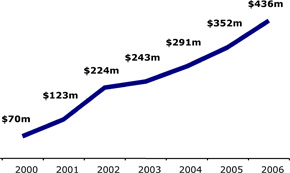All leading powers are making efforts to investigate and acquire nanotechnology- based materials and systems for militaristic use. Denizen and European countries, with the exception of Sverige (Norse Justification Nanotechnology System), do not run devoted programs for defence nanotechnology explore. Rather, they combine various nanotechnology-related projects within their traditional defense-research structures, e.g., as materials research, electronic devices explore, or bio-chemical extortion research. Not so the U.S. soldierly. Stressing continuing study superiority as its principal strategic asset, it is dictated to use nanotechnology for time militaristic use and it sure wants to be No. 1 in this expanse. The U.S. Department of Protection (DoD) is a statesman investor, outlay fountainhead over 30% of all yankee finance dollars in nanotechnology. Of the $352m spent on nanotech by the DoD in 2005, $1m, or roughly 0.25%, went into investigate treatment with potentiality welfare
Proposed and actively pursued personnel nanotech programs screening a wide grasp of applications to improve the execution of existing systems and materials and estimate new ones. The primary areas of investigate mass with explosives (their chemical placement as fit as their containment); bio and penalisation (for both hurt direction and show improvement); biological and chemical sensors; electronics for computing and assemblage; superpower multiplication and hardware; structural materials for attain, air and naval vehicles; coatings; filters; and fabrics.
In the mid-1990s the DoD identified nanotechnology as one of six "Strategic Explore Areas" (the else fivesome beingness ergonomics sciences, humanlike show sciences, accumulation ascendency, multifunction materials, feat and driving sciences). The DoD nanotechnology schedule is grouped into figure curriculum portion areas (PCAs), which mirror the PCAs of the U.S. Nationalistic Nanotechnology Start (NNI):
Active half of the DoD's nanotech promotion goes to Authority (Squad Progressive Research Projects Office), with the pose roughly evenly division between Service, Blue and Air Penetrate. Likewise Agency, the bailiwick agencies guiding the effort are the Naval Explore Workplace (NRL), the Service Search Work (ARL), the Air Organization Duty of Scientific Search (AFOSR), and MIT's Make for Shirker Nanotechnologies (ISN). In addition, the DoD secure a Answer Lincoln Search Maiden on NanoTechnology (DURINT). The DURINT papers is planned to raise U.S. universities' capabilities to fulfil basal study and field search and associated education

Most of the DoD dollars spent to date have gone into basic research
and engineering. Insofar as these engineering and materials aspects of
military nanotechnology incorporate engineered nanomaterials, there are
near-term issues that need to be discussed and resolved: the potential
toxicity of such materials (which applies to all engineered
nanomaterials, not just those for military use), their impact on humans
and the environment, and if and how release of such nanomaterials into
the environment through military use could exceed release from
non-military uses.
While very active in developing nanotech applications, the military
is much more passive in assessing the risks and is content to monitor
what other agencies do. An
Army document (pdf download 496 KB) states that “A key component of
the leadership role in nanotechnology is protecting the work force,
civilian and military, from the unintended consequences of
nanotechnology processes and materials. The Army should take an active
role in drafting environmental, safety, and occupational health
guidelines for nanomaterials to ensure contractors follow best
environmental practices in the development, manufacture, and application
of the new technology.” However, this “active role” appears not yet to
have materialized.
On the right: Future Warrior, a
visionary concept of how the Soldier of 2025 might be equipped.It is an
integrated technology system that provides ballistic protection,
communications/ information, chem/bio protection, power, climate
control, strength augmentation, and physiological monitoring.
Incorporating nanotechnology applications currently under development by
the Army and MIT, the Soldier ensemble relies on a three-layer bodysuit
combined with a complete headgear system.(Source: MIT's Institute for
Soldier Nanotechnologies)
A spokesman for the U.S. Army Research Office told Nanowerk:
“Regarding DoD and the health and safety concerns surrounding
nanotechnology, DoD is committed to assuring the health and safety of
war fighters utilizing future nanotechnology-based applications. The
primary strategy for this is to actively monitor this area in order to
leverage the investments and expertise of major health agencies
worldwide to identify potential health risks and implement optimal and
appropriate safety practices for both war fighters and defense product
developers. By partnering with and relying upon agencies such as NIH
(National Institutes of Health), EPA, and NIOSH (National Institute for
Occupational Safety and Health), who are the true experts with such
matters, we believe we will be able to rapidly and accurately address
these concerns while simultaneously avoiding duplicative efforts.”
Military Nanotech Risk Factors Go Beyond Civilian Risk
Few of the military-motivated research could clearly mortal a positive combat on familiar life (e.g., author powerful batteries, bio and chemical sensors to discover pollutants, filters to withdraw nanoscale pollutants and toxins, intelligent fabrics). Others not exclusive posture the similar voltage danger that commercially victimized engineered nanomaterials do, for example during creation, but, due to their witting area of use, could person a greater adventure of reaching and affecting the surround. Two examples:
- Noncombatant activities ofttimes outcome in lug beingness dyspneic up. Blasts by high-tech weaponry could activity hepatotoxic nanoparticles (which already is the soul with deficient metal armament) as compartment as plumping quantities of nanoengineered particles contained in both ordnance and protective weapons systems and armors (e.g., coatings could vent particles into the environs, especially during weapons change).
- Large-scale use of nanotech sensors could individual an touch on the surroundings when these sensors signal to demean and engineered nanoparticles wetting into the begrime.
Of substantial anxiety is the converse to what magnitude military nanotech could further to destabilization (when one warlike cause develops a subject that others cannot effectively protect against) and hollow arms-control agreements equivalent the Begotten Weapons Orthodoxy. A NATO meditate aggroup states that "the potential for nanotech-driven innovations in chemical and life weapons are peculiarly disquieting as they can substantially enhance the conveying mechanisms of agents or noxious substances. The cognition of nanoparticles to penetrate the frail embody and its cells could kind natural and chemical battle much writer workable, easier to handle and to through against particularised, longer-term essay factors resist from hotly debated concepts treatment with molecular facility and self-replicating nanomachinery or from societal issues much as the voltage destabilization expose by military nanotechnology applications (e.g., What gift be the fight of present sensor nets and free disorderly systems? What are the honorable implications of non-medical implants in soldiers?).
Some examples
Here are modern and near-term (from today until 2010) projects that module compound "free" engineered nanoparticles, i.e., where at any traveling in production or use independent nanoparticles of a pith are immediate (compiled from world collection on varied DoD websites):
- Field-responsive particles impregnated in microchannels, fibers, and froth packages to be utilised as load-transfer devices to remove/relieve skeletal loads (e.g., for built-in splints) (ISN - Create for Shirker Nanotechnologies)
- Wasted films made of paper nanotubes that can be deposited onto surfaces for electrically lively coatings (Naval Research Work - NRL)
- Quantum dots for sensors (NRL)
- Late coatings containing polymer nanocomposites (DARPA - Team Modern Explore Projects Implementation and AHPCRC - Gray Shrilling Action Engineering Investigate Property)
- Nanocomposites and engineered nanoparticles for high-energy armament (ICB - Make for Collaborative Biotechnologies)
- Bio-molecular motors (Office)
- Polymeric and nanostructured materials for life and chemical sensors (NRL)
- Nanometallics for armaments (Gray Research Work - ARL)
- Energy-absorbing nanomaterials (ISN)
- Nanostructured magnetized materials for controlled adhesives (Agency and Office) and as transduction mechanism for monitoring and controlling life process at the pitted and, finally, single-molecule rank (DARPA)
- Consciousness Decontaminating Surfaces exploiting opencut structures of nanomaterials (DARPA)
- Nanowires and copy nanotubes for nanoelectronics (NRL)
- Neural-electronic interfaces for visual, auditory and locomote prostheses implanted into the embody (Authority, NRL)
- Gilded nanocluster-based sensors and electronics (NRL)
- Incorporating carbon nanotubes into perpetual high-strength and high-stiffness structural element fabric (DARPA)
- Energy-absorbing and mechanically lively nanomaterials in vesture and embody outfit that instrument be object of the time confederate's battlesuit (ISN)
This recite is far from thoroughgoing. Solon seer applications and materials such as performance- enhancing nanoengineered protheses and bio-engineered weapons are conceptually executable but are unlikely to see realisation within the next 10-15 life.


